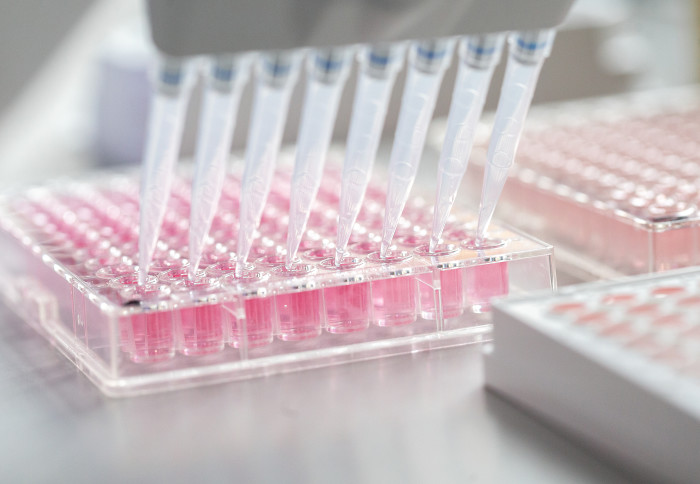Imperial vaccine tech to target COVID mutations and booster doses

Imperial is focusing its RNA vaccine technology to target SARS-CoV-2 mutations, boosters and thermostability rather than an immediate efficacy trial.
"We want our technology to have the greatest impact. That means developing self-amplifying RNA technology to adapt to new variants, to boost other vaccines and to be deployed against future pandemic threats." Professor Robin Shattock Imperial College London
As other COVID-19 vaccines are being licensed and rolled out, Professor Robin Shattock’s team is working to maximise the impact of their groundbreaking self-amplifying RNA technology.
This includes developing the ability to respond rapidly if vaccine-resistant strains emerge, or the need for booster vaccines arises.
It also offers the possibility of more thermostable RNA vaccines that can be stored in ordinary refrigerators.
The saRNA technology’s development accelerated during the COVID-19 pandemic, with a combined phase I and II clinical trial involving over 400 participants. The results of these studies are still pending and will inform the next steps of development.
Clinical trials continue
The trial is still ongoing and collecting valuable data, with further insights set to inform next steps at the clinical phase, which may include testing different formulations of the vaccine, and, pending approval, modifications to deal with new variants of coronavirus.
Given the number of vaccines already approved and being distributed, rather than proceed with an immediate phase III efficacy trial in the UK, the group will focus on emerging and longer-term coronavirus threats such as variants and mutations, and more powerful booster vaccines. The team are still exploring the possibility of a phase III trial overseas.
Targeting new variants

Imperial’s saRNA technology has the potential to rapidly adapt and target new variants and viral mutations of SARS-CoV-2 or other viruses and diseases as they emerge. This capability could be central in developing second generation vaccines for COVID-19 and against future diseases and epidemics.
The Imperial vaccine technology may also provide a crucial booster for first generation COVID-19 jabs, as we learn more about population responses to these early vaccines.
The team has also developed approaches that could enable RNA vaccines to be stored in ordinary refrigerators for months, rather than the extremely low temperature required by current generation RNA vaccines. Bringing this to clinical readiness will also be an important next step.

Professor Robin Shattock, from Imperial's Department of Infectious Disease, said: “Although our first generation COVID-19 vaccine candidate is showing promise in early clinical development, the broader situation has changed with the rapid roll out of approved vaccines. It is not the right time to start a new efficacy trial for a further vaccine in the UK, with the emphasis rightly placed on mass vaccination in response to the rapid spread of the new variant.
“We want our technology to have the greatest impact. That means focusing our UK efforts on developing self-amplifying RNA technology to adapt to new variants, to boost other vaccines and to be deployed against future pandemic threats. We want to develop Imperial’s technology as a safety net to catch escape mutations, reach variants that other vaccines may not and meet potential needs for annual booster vaccinations.
“We are also providing the UK with long-term capability in RNA vaccines for COVID-19 and other potential infectious threats. We are working with philanthropists, investors, government and industry partners to take this exciting technology further.”
Future vaccine production

"This exciting technology will help accelerate future vaccine production, providing the agility to defend against viral mutations, and protect current and future generations from pandemics." Alice Gast President of Imperial College London
Imperial’s self-amplifying RNA technology could be central to the UK’s future RNA vaccine R&D and manufacturing capacity.
Hundreds of donors have supported the Imperial RNA vaccine research and development so far, with their multi-million pound backing enabling rapid progression to clinical trials, alongside government and private sector investment. Philanthropic support will be crucial to the next stages of technological development.
Government investment also enabled the research and trials, and will continue to support future development.
Professor Alice Gast, President of Imperial College London, said: “Imperial’s self-amplifying RNA vaccine has much to offer in the fight against coronavirus and other diseases. This exciting technology will help accelerate future vaccine production, providing the agility to defend against viral mutations, and protect current and future generations from pandemics.
"Robin Shattock’s team have made great advances to reach this point, and we are proud of their rapid achievements. As philanthropic, government and industry partners back the technology’s next phases of development, we expect to see exciting developments over the coming months.”
Professor Fiona Watt, Executive Chair of the Medical Research Council, which helped to fund the research, said: “The Imperial team has worked incredibly hard over the past year to develop a new self-amplifying RNA vaccine for COVID-19, which is currently in early-stage human trials. Although the outcome of those trials is unknown, the decision has been taken not to progress to Phase III trials in the UK. This is because several COVID-19 vaccines have already been approved. Rather than conducting immediate further clinical trials, the Imperial team can now focus their research on how their exciting new technology can be used to develop new or improved vaccines.”
Article text (excluding photos or graphics) © Imperial College London.
Photos and graphics subject to third party copyright used with permission or © Imperial College London.
Reporter
Andrew Scheuber
Communications Division